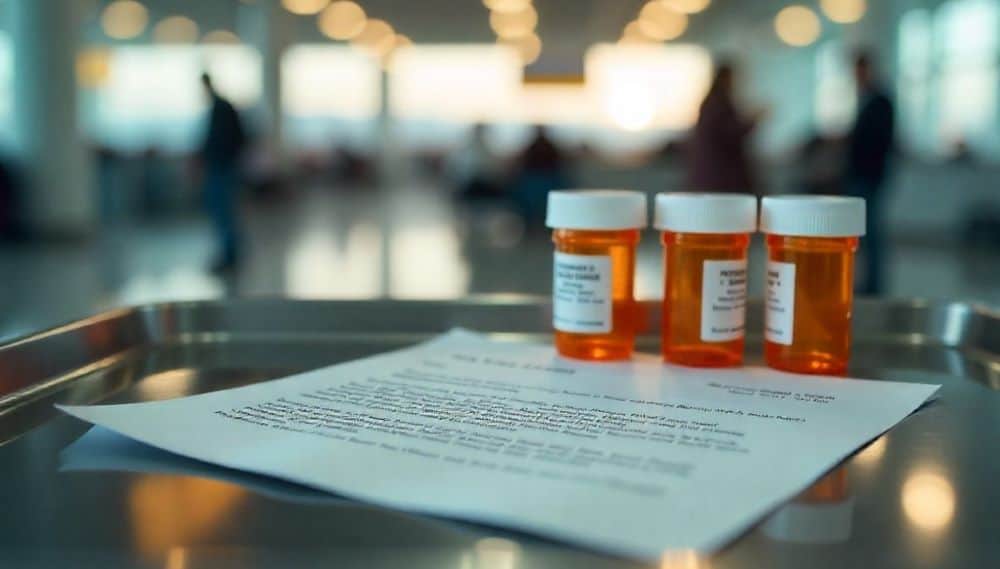What Are the TSA Rules for Prescription Pills When Flying in 2025?

Planning to travel with prescription medications this year? Understanding TSA rules for prescription pills can save you time, stress, and potential delays at airport security. Whether you’re carrying a few daily vitamins or multiple prescription bottles, here’s everything you need to know about flying in the US with medications.
For more comprehensive information that includes overseas travel by air, be sure to check out my comprehensive guide to Flying with Medication.
1. TSA Prescription Medication Rules: The Basics
Good news: TSA allows unlimited amounts of prescription pills and solid medications in both carry-on and checked luggage. Unlike liquids, there’s no size restriction on pill bottles or quantity limits for personal use.
Key TSA Rules
- ✅ Unlimited prescription pills allowed in carry-on bags
- ✅ No need to remove pill bottles from your bag during screening
- ✅ No requirement to declare solid medications to TSA officers
- ✅ Pills can stay in original bottles or pill organizers
- ✅ Over-the-counter medications follow the same rules
2. Should You Pack Prescription Pills in Carry-On or Checked Luggage?
Always pack prescription medications in your carry-on bag. Here’s why:
Airlines lose approximately 7 bags per 1,000 passengers. If your checked bag goes missing, so do your essential medications. On international flights, replacing prescriptions can be complicated, expensive, or impossible.
You need access during long flights. Many medications require specific timing that doesn’t align with baggage claim schedules.
Temperature extremes in cargo holds can damage certain medications, especially during summer heat or winter cold.
3. Do Prescription Pills Need to Be in Original Bottles?
TSA doesn’t require prescription pills to be in original pharmacy bottles, but keeping them labeled is smart for several reasons:
3.1 TSA-Recommended approach for Packing Meds:
- Keep pills in original labeled bottles if they are controlled substances
- Pill organizers are allowed but carry some risk
- Bring a medication list with generic names
- Consider photographing prescription labels before travel
Real traveler mishap
My reader Tom thought he was being smart by consolidating all his pills into a single weekly organizer for his business trip to Phoenix. His white blood pressure pills, beige cholesterol medication, and small white anxiety pills all looked nearly identical in the compartments.
Midflight, he accidentally took his anxiety medication instead of his blood pressure pill—double the dose he needed. Worse, when he had chest pain later and paramedics arrived, they couldn’t identify what he’d taken because everything was unlabeled. “I spent 6 hours in the ER getting my stomach pumped because they didn’t know if I’d overdosed,” Tom told me. “If I’d kept everything in original bottles (at least my anxiety medication), the doctors would have known immediately what I’d taken and treated me properly. A $3,000 out-of-network hospital bill taught me that pharmacy labels exist for a reason.”
The takeaway: Those pharmacy labels aren’t just for TSA—they’re your medical lifeline. In emergencies, first responders need to know exactly what you’ve taken to treat you safely. A few extra minutes organizing labeled bottles could literally save your life and thousands in medical bills.
3.2 Why original bottles help:
- Faster screening if TSA has questions
- Easier identification of each medication
- Proof of legitimacy if questioned
- Medical emergency information for healthcare providers
4. Liquid Prescription Medications: Special TSA Rules
Liquid medications are exempt from the 3-1-1 rule but require additional steps:
4.1 TSA liquid medication requirements:
- Declare liquid medications at the security checkpoint
- Remove them from your bag for separate screening
- Carry “reasonable quantities” for your trip
- Keep in original labeled containers when possible
Examples of liquid medications:
- Cough syrup and liquid cold medicine
- Insulin and injectable medications
- Liquid vitamins and supplements
- Eye drops and nasal sprays

Check out my article “Flying with Liquid Medication” for more details.
5. Flying with Controlled Substances
Controlled medications require extra documentation for international travel:
5.1 High-risk medications include:
- ADHD medications (Adderall, Ritalin)
- Anxiety medications (Xanax, Valium, Ativan)
- Pain medications containing opioids
- Sleep aids and muscle relaxants
5.2 Essential documentation:
- Doctor’s letter explaining medical necessity
- Original prescription bottles with your name
- Pharmacy receipt or prescription printout
- Research destination country requirements
6. TSA Medication Screening Process
6.1 What to expect at TSA checkpoints:
- Place carry-on bag on X-ray belt – pills can stay inside
- Declare liquid medications if you have any
- Answer questions honestly if TSA officers ask
- Additional screening is rare for solid medications
- Keep moving – most travelers pass through without issues
6.2 If TSA officers have questions:
- Remain calm and cooperative
- Explain medications are for personal medical use
- Provide doctor’s letter if available
- Ask for a supervisor if needed
7. Common TSA Medication Mistakes to Avoid
1. Packing All Medications in Checked Luggage Lost luggage means lost medications. Always carry essentials in your carry-on.
2. Not Bringing Enough Medication Travel delays happen. Pack extra medication beyond your planned trip length.
3. Forgetting Doctor’s Letters for Controlled Substances. Chances are you won’t be stopped, but if you’re asked about those sleeping pills by a TSA agent, you want medical documentation. Otherwise that bottle of Ambien may be confiscated.
8. Medication Travel Timeline
8.1 Before your trip:
- Schedule doctor appointments 4-6 weeks before international travel
- Request early prescription refills for extended trips
- Research destination medication laws
- Download photos of prescription labels to your phone
- Pack twice as much medication as you think you’ll need
8.2 At the airport:
- Arrive early to allow time for any medication-related screening
- Keep calm if questioned about medications
- Have doctor’s letters easily accessible
- Consider TSA PreCheck to streamline security
8.3 During travel:
- Keep medications in your personal item, not overhead bins
- Take medications on your home schedule initially
- Gradually adjust to new time zones for non-critical medications

9. What Happens If TSA Confiscates Medication?
TSA rarely confiscates prescription medications unless:
- They appear suspicious or unlabeled
- Quantities seem excessive for personal use
- They’re in unmarked containers with no identification
If medication is questioned:
- Provide doctor’s letter or prescription information
- Explain your medical condition calmly
- Ask to speak with a TSA supervisor
- Request the Complaints Resolution Officer if necessary
Read more in our in-depth article Can TSA Take Your Medication? Know Your RIghts.
10. Frequently Asked Questions (FAQ’s)
10.1 Can I bring vitamins and supplements on a plane?
Yes, vitamins and over-the-counter supplements follow the same rules as prescription medications.
10.2 How many prescription bottles can I bring in my carry-on?
There’s no limit on the number of prescription bottles for personal use.
10.3 Do you need a doctor’s note for domestic flights?
TSA doesn’t require doctor’s notes for domestic travel, but they can be helpful for liquid meds, controlled substances and injectables if questions arise.
10.4 Can I bring prescription medication for my family members?
A: Yes, you can carry medications for immediate family members traveling with you.
10.5 What if my medication needs refrigeration?
Bring insulated cooling cases and declare them at security. Ice packs are allowed for medical purposes.
10.6 Can you bring pills in a ziploc bag on a plane?
Yes, you can bring pills in a Ziploc bag on domestic flights because the TSA doesn’t require prescription medications to be in their original containers for security screening purposes. However, keeping them in original labeled containers is still recommended so you can easily identify the medication and prove it’s legitimately yours if questioned by TSA agents.
11. Wrap Up
Understanding TSA rules for prescription pills when flying eliminates stress.
Remember: Domestic travel with routine prescription medications is straightforward – original bottles are not required for standard pills, no advance notifications needed, and no documentation required for everyday medications.
With proper planning and documentation, you can safely bring your prescriptions anywhere in the world. When in doubt, contact TSA directly at @AskTSA on social media or at TSACares online–or call their contact center at 866-289-9673.
The key is knowing when special rules apply. Controlled substances, large liquid medications, and international travel require extra preparation, but even these situations are manageable with proper planning.
Remember: These rules can change, so always check the current TSA website before traveling. Your health and peace of mind are worth the extra preparation time.






